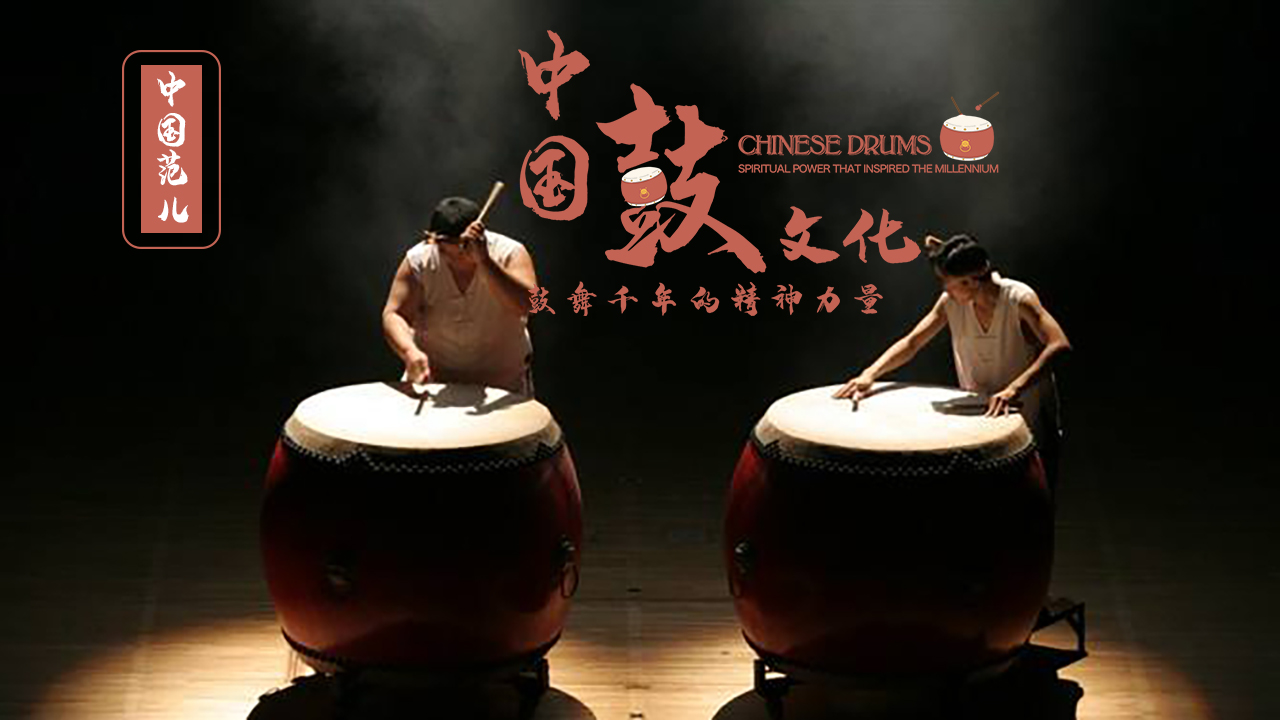中國鼓文化:鼓舞千年的精神力量
鼓文化與中華文明相伴而生數千年,其所承載的精神內涵已經遠超其樂器的用途。先賢孔子曾説過“鼓之舞之”,可見“鼓舞”一詞起源之早。
Drum culture has accompanied Chinese civilization for thousands of years and has a deep spiritual connotation which takes its existence far beyond that of a musical instrument. Confucius regarded the "Drum Dance” highly. It is also the origin of the word “embolden” in Chinese.

在2008年的北京奧運會閉幕式上,200名身著紅衣的鼓手組成圓形鼓陣舞動擊鼓,在鼓點的律動中,全球觀眾見證了這場“無比倫比”的奧運盛會的完美落幕。中國鼓彰顯了中國作為一個擁有悠久歷史的文明古國應有的風度與大氣。
At the closing ceremony of the 2008 Beijing Olympic Games, 200 drummers in red formed a round drum array to dance and beat drums. The perfectly synced beats drew the curtain on the exeptional Olympic Games. Chinese drum is an ancient practice which reveals that Chinese culture has a deep history.

中國鼓,最早是以陶土燒制的“土鼓”,始現于陶器時代。周朝設立了專職管理鼓樂的機構,負責管理的官吏被稱為“鼓人”,同時制定了一套完備的鼓樂制度。從那時起,鼓就已經規範地用於古代中國祭祀、軍事、勞作及其他活動中。
The earliest reference to a clay fired drum is in the Pottery Age. The Zhou Dynasty had drum music institutions that were responsible for the management of officials known as “drum man” besides developing a complete drum music system. Since then, drums came to be used in ancient Chinese practices such as sacrifice, military, labor and other activities.
中國古代社會以農業生産為主,鼓也是人們生産生活中一種不可或缺的器物。由於鼓聲似雷霆,人們認為打鼓可以引來雨水,滋潤農作物生長,鼓順理成章地成為了向神靈祈禱風調雨順,與神靈“溝通”的方式。各朝各代,皇帝都會舉行祭祀天地的儀式,雄壯的鼓樂響徹了千年時空。
In ancient China, agriculture was the main form of production and drums were considered indispensable for a bumper harvest. Since the sound of drums echoes that of thunder, it was believed that playing drums could attract rain and nourish crops. So the instrument was used to pray to the gods for good weather and to “communicate” with them. In each dynasty, the emperor held a ceremony to worship heaven and earth and majestic drum music was heard alongside.
鼓在戰爭中也發揮著重要的作用。由於鼓有良好的共鳴作用,聲音激越雄壯而傳聲很遠,所以很早就被作為軍隊上助威之用。
Drums also play a part in the war. Because of a strong resonance effect, the drum’s sound can go long distances while striking fear in the heart of the enemies. So it has been used as a military booster for a long time.

至唐宋時期,社會欣欣向榮,鼓的應用範圍更加廣泛,民族樂隊、戲劇、曲藝、歌舞、賽船舞獅、喜慶集會、勞動競賽等都離不開鼓類樂器。鼓真正走入了大眾百姓的生活各處,鼓聲為人們生活帶來歡慶和希望。
In the Tang and Song Dynasties, the society was thriving and put drums to myriad uses. The national band, drama, folk art, song and dance, boat racing and lion dance, festive assembly and labor competition were accompanied by the beats of drums. The sound of drums became synonymous with celebrations, filling hearts with joy.
如今的中國鼓,已然有數十個鼓種。例如用來寄寓人們對太平盛世、五穀豐登嚮往的“太平鼓”;展現黃土高原氣概,西北農民豪邁性格的“安塞腰鼓”;有豪邁大氣的河南開封“盤鼓”、陜北洛川“蹩鼓”等;也有小型多樣,靈活纖巧,並帶有演繹情節的南方鼓舞——安徽“鳳陽花鼓”、江蘇“漁籃花鼓”、湖南“地花鼓”等。鼓文化的繁榮,反映的是中國社會的安定繁榮,正如千百年來,安居樂業的社會環境必然伴隨著鼓樂齊鳴的盛景。
Dozens of types of Chinese drums exist today. For instance, “Taiping drum” is used to express yearning for peace and prosperity while “Ansai waist drum” is meant to depict the spirit of the Loess Plateau and the heroic character of Northwest farmers. Then there is the celebration of grit and heroism of "Pangu" in Kaifeng of Henan Province and "Biegu" in Luochuan of Northern Shaanxi Province. There are also small, flexible and delicate Southern drum dances with deductive plots - "Fengyang flower drum" in Anhui Province, "fishing drum" in Jiangsu Province, "Basket flower drum" and so on. The prosperity of drum culture reflects the stability and prosperity of Chinese society. For thousands of years, the drum beats have played in the backdrop as the society lived in peace and contentment.

.










